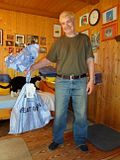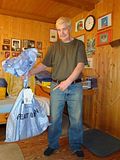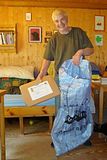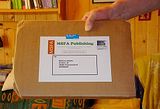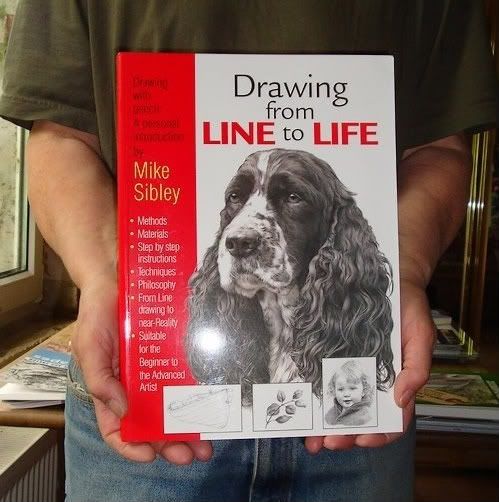
June 27, 2009
Just a drawing

June 20, 2009
Mike Sibley's book Part II
What I like very much is that in his paintings there are rarely the pencil strokes visible, you know what I mean?
Some artists only work with strokes, bigger, finer, heavier, lighter, hatched, cross hatched, all visible strokes. Mike prefers to see not the single stroke and this is what I like.
And another thing was remarkable for me. Mike mostly uses clutch pencils but I never liked them and preferred wooend case pencils. I do not care if the weight in my hand changes. But I gave the 'Clutchers' another chance to become friends with me. And - tadaa - we became close friends.
I had the chance to purchase five clutchpencils made by Staedtler for 5 $ - which is VERY cheap here - and some leads (F-C). I already had mechanical pencils and bought some GOOD leads for them also - and I can't believe why I didn't used them before.
It is much easier - no sharpening or only sharpening the lead with a tiny lead sharpener (F-C) which I can hold easily. The leads I bought are wonderful also. I have no idea if the Staedtler leads are very different or how, but I am satisfied with these clutch pencils and their 'fill-ups'. :)
So I already benefit from the book. Joanie, a close friend, mentioned at PPN, that she finds the price too high and I I think too that this book is a little bit overpriced (not my reduced copy). But when I compare it with the books we can buy here in Germany where we have to pay 16 $ for a tiny brochure size A5 (140 x 210mm) and not more than 40 pages with big letters it is cheaper than everything in Germany. In general seems Germany to be a developing country concerning pencil art, especially colored pencils.
So Mikes book is much more worth than these - how much I will know when I go on. And he is an outstanding artist, very well known and maybe the name raises the price too.
I guess there are many books about drawing in USA and UK which are at the same level and cost only the half or less. Can you recommend good books on graphite drawing?
June 19, 2009
I'm a Fan!!! (Part I - Music)
June 16, 2009
GOT IT!
June 06, 2009
Drawing day 2009
June 03, 2009
Ouch



May 20, 2009
A win and many ATCs



May 07, 2009
Kristy Kutch on WCPs
Watersoluble Pencils Include Watercolor Pencils- Plus New Varieties
Originally, the watersoluble pencil was a watercolor pencil, featuring a rod of watersoluble pigment-plus-binder neatly encased in a wooden sheath. This type of pencil is widely available and offers plenty of exciting, vivid possibilities and a tremendous range of colors.
Cretacolor of Austria produces a watercolor pencil tapered rod, a very dense, heavy aquamonolith which is all pencil-product and no wood casing. Cretacolor also has introduced (in 2008) Marino watercolor pencils, lightfast watercolor pencils in 36 colors.
Cretacolor also markets a range of watersoluble graphite pencils, which apply like graphite but which dissolve into grey washes when wetted.
British Derwent Watercolour Pencils were available for many years in 72 shades, each hue corresponding to one of their wax-based Studio Pencils. Recently, though, Derwent has expanded the definition of watersoluble pencils, adding 24 colored graphite pencils, Graphitint Pencils, to their line. These can be used dry or wetted with a brush for surprising hues-that-pop.
Another unique Derwent pencil is the collection of 72 Inktense Pencils, described by the manufacturer as the first watersoluble ink pencils. Inktense pencils are quite vivid when dry and stay brilliant and vivid after being dissolved. They are also more staining and permanent than watercolor pencils (so watch that white shirt or blouse!) Jane DeMeyer of Oconomowoc, Wisconsin created a stunning Hawaiian sunset with Inktense pencils which truly showcased their vivid intensity.
The watersoluble pencil may be used for dry drawing and left completely dry and textured. (It is not possible, however, to sharpen it to a needle-fine point like that of a Verithin pencil.) It also can be wetted with a solvent blending-marker, which releases the pigment so that it looks a little grainy but mostly dissolved. The most stunning effects can be seen when the pencil layer is wetted with a damp brush or spray bottle, allowing the pigment to transform into a dissolved wash. Watersoluble pencils can also be drawn heavily onto a spare piece of paper to make a homemade palette, wetting the swatch and dipping the brush into it for painting details right from that custom-mixed puddle of pigment. There are other possibilities for drawing with a wet pencil tip into an already-wet area for a streak of intensity, drawing dry into a wet area for a finer "shot of color", spattering the wet pigment with a toothbrush for a loosely airbrushed look, and grating the pencil pigment onto a damp area for some dynamic, intense grains of color.
Another consideration is to apply the watersoluble pencil(s) on a white surface, brush over the pigmented layer with a wide, wet brush, and thus tone (tint) the drawing surface. This do-it-yourself color selection is especially helpful to the artist who would like to find a certain shade of colored paper or board which is simply not available. Gail Ribas of Acadia Workshop Center in Southwest Harbor, Maine, paints dynamic landscapes in pastel, watercolor, or colored pencil. She said that often she often begins by toning her white paper or board with a shade of orange, then proceeds with blues for the sky and water over that orange surface. The underlying orange complementary color (the opposite color on the color wheel) adds an amazing, vibrant "pop" to the landscapes and surprisingly does not "scream" orange at the viewer. (This surface-toning process would be a good application for the more permanent Inktense pencils.) Of course, the white drawing surface could be tinted blue, lavender, green, or any other desired color.
Watersoluble pencils can be used for interesting background effects, too. Protecting the drawing of objects in the foreground with frisket film (cut in the pattern to cover it), then spattering with a toothbrush is one option. This creates a loose, pleasing background that I have nicknamed "poor man's airbrush". Yes, it is certainly a good idea to practice it on scrap paper first. Learn to dab off the toothbrush at least 4 or 5 times to control excessive drips. Once mastered, though, it is fun and unique.
Recently, while I was finishing a coastal scene, my ocean waters looked too placid against those rugged boulders. (Although it was a calm day, the scene still needed some artistic license and begged for a little action!) I worked upon an idea (once suggested by a student during a demonstration) for that sea-spray that rises up from white-capped waves. This technique for foamy wave action is quick, fun, and quite natural-looking. After the water was drawn and developed almost to completion, I carefully flicked some clear water (with a soft toothbrush) on the crest of a wave. Then I quickly grated my white watercolor pencil over the tiny wet dots and the white pencil granules clung to them just like sea foam! I even added a little grated pigment in an aquamarine color to that white foam, plus a light shade of ultramarine blue, to give the froth some depth, subtle shadows, and dimension. After this process, I allowed it to dry and then sprayed the whole piece with a fixative spray.
Many years ago, as a beginning watercolor student, I truly struggled with lifting dry watercolor pigment by dragging a kneaded eraser across the area. Sometimes it worked and sometimes it was futile, depending upon how staining and permanent that particular pigment happened to be. A white plastic eraser works much better, I have learned. A battery-powered white plastic eraser is amazing for lifting dry pigment! (Do not try this when any part of the painting is still damp, as those flying eraser crumbs cling to wet areas!) Just remember to let the paper dry thoroughly before erasing, so as not to damage, gouge, or scar it.
A new valuable hint (which I recently learned from www.wetcanvas.com ) is for gently lifting an area to be lightened with a damp Mr. Clean Magic Rub Eraser. This is a cleaning product commonly found in the grocery store, and it costs about $2 for a package of 2 Magic Rub Erasers. It does not require the artist to scour the painting surface, just lightly brush across it. Rinse the eraser, blot the surface, and repeat the process if necessary. Be sure to purchase the original, no-frills version of this product, not the one with Febreze added.
Note: Newly accepted under the definition of “colored pencil” by the Colored Pencil Society of America are watersoluble crayon products. Most frequently mentioned are Caran d’Ache Neocolor II (126 colors), but the (discontinued) chunky crayon-like watersoluble Stabilotones are included, too. I contacted the C.P.S.A. national board about whether Lyra Aquacolors (48 colors), Cretacolor Aquastics (80 colors) or the discontinued Faber-Castell Aquarelle Sticks (40 colors) also fall under this definition, but have not received a reply. I am assuming that “no news is good news” and they they are colored pencil products, too, since they seem to be similar products.
May 04, 2009
Long lazy weekend ....
I haven't done much artwork the last days. There are days where I better don't touch a pencil or something with which I could ruin a painting. *lol
But I took a great photo (at least I love it and must laugh when I look at it). Some of you know that we have 9 cats, all former street-kitten who lost their mothers. In 2003 we picked up a twin pair who was only about 14 or 17 days old (eyes just had opened). The yearned and yearned about 200 metres away from our home but I heard them - whyever. Hubby and I went there and found these two babies - crawling on the street!  The neighbours there said that the mother was away and one sibling already killed by a car - but "we don't care, they are old enough and will survive, we give them a little milk." They couldn't even walk and because of hunger they where on the street - Gosh - I was such angry.
The neighbours there said that the mother was away and one sibling already killed by a car - but "we don't care, they are old enough and will survive, we give them a little milk." They couldn't even walk and because of hunger they where on the street - Gosh - I was such angry. 
So we picked them up, both where not very healthy because of so much unger and milk the got. But we made them healthy (thanks to homoeopathics and a good vet later) and of course they still live with us.
The twin brother is a great "washer". He loves to slick heads, especially hubbies head when he sleeps. And you know how rough a cats tongue is. But hubby "nothing-can-disturb-my-TVsleep" didn't notice that mostly. Yesterday I had the chance to take a photo of these two pretty guys. :) Look:

sometimes a good photo is better than a ruined piece of art. 
At PPN we just have our first ATC exchange, I am very excited and hope that many of our members will participate. I love these ATC trades, it is wonderful to send and to receive these tiny artworks from all over the world. If you feel the same come and join us, our network is growing every day and I am very proud to be a member if the pencil painters!
